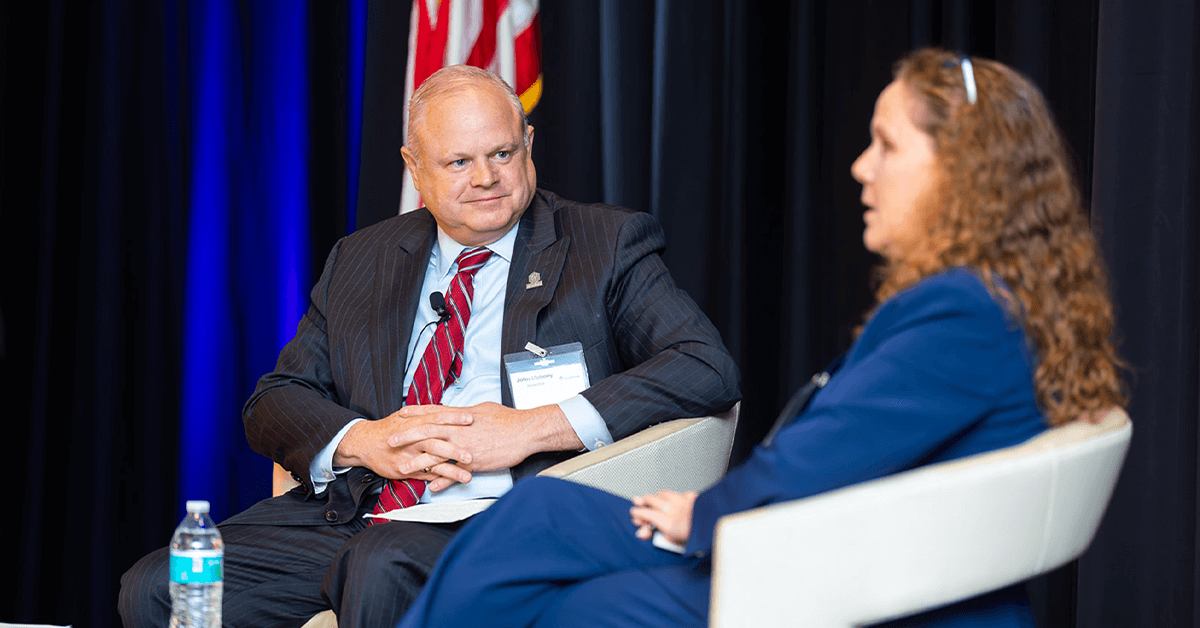Over time, acquisition processes in the federal government, particularly in the Department of Defense and space realms, have become more flexible and amenable to specific situations and users. In the last half decade or so, veteran DOD servants say changes such as these and others have breathed new life into the development and production of technologies needed to arm warfighters.
“A few years ago…there was a shift within the acquisition world to put forth some different kind of pathways that program managers might choose that might be more appropriate for specific applications,” recalled Stephanie Possehl, director of space and missile defense for the office of the undersecretary of defense for acquisition and sustainment. Possehl, whose experience balances equally between PM appointments and engineering work, spoke in conversation with SpiderOak Senior Vice President John Moberly at the Potomac Officers Club’s April 27 Industrial Space Defense Summit.
Possehl used the fireside chat to highlight the changes she has observed in A&S methodologies and their impacts on DOD technological progress. One of the biggest new wrinkles she has appreciated is the creation of the middle tier acquisition option.
The middle tier acquisition, or MTA, is differentiated from the traditional method— major capability acquisition—through two pathways, the first of which is rapid prototyping. This acceleration encourages developers to build something and “get it out into the field or space within five years,” per Possehl.
When practitioners are able to exercise this pathway, the process is extremely streamlined. The once mandatory Joint Capabilities Integration and Development System requirements can be bypassed and along with them, a lot of extraneous documentation.


“It’s really focused on demonstrating some capabilities quickly, getting them into some operational use, and then seeing where you want to go from there,” Possehl said of rapid prototyping. She continued, adding that the Space Development Agency has made good use of MTA, pumping out “rapid prototype after rapid prototype” in their tranche capability endeavor.
The second definitional element of MTA is the software pathway, quite simply, the “acknowledgement that software is a continuous development and fielding cycle,” according to Possehl. Moberly approved of this aspect heartily, noting that while the saying goes that ‘software is eating the world,’ the federal government has not adopted “the best approaches for acquiring software. So that is critical work that A&S is doing.”
In her explication of MTA, Possehl also mentioned rapid fielding, which allows for a condensed timeline of getting a tool into production in anticipation of needing it within a targeted amount of time in the future. Similar to rapid prototyping, this pathway guts some of the bureaucracy from the pipeline. She said it hasn’t made a big splash yet, particularly in the space domain, but that it likely will down the line.
In terms of other modifications to the acquisition process in recent years, Possehl is a big proponent of a Joint Staff effort called the capability portfolio management reviews. These reviews are a comprehensive evaluation of what current systems are covering and not covering and aim to reveal where gaps in capabilities lie within ongoing R&D initiatives as well as fielded technologies.
“I think that…approach to, let’s have an architecture, let’s look at things as portfolios, Let’s make sure that the capabilities that we’re spending money on actually work to achieve the missions that we’re trying to achieve is going be really important,” Possehl proffered when Moberly asked how her office was thinking about budget proposals for fiscal year 2024.
In addition to financial prudence, she said CPMRs work against the stovepiping of different programs and promote a sense of fluid communication and understanding. In this way, she submitted that CPMRs would be useful in helping to complete Assistant Secretary of the Air Force for Space acquisitions and Integration Frank Calvelli’s nine space acquisition tenets, which include an emphasis on not prolonging contract activities and being realistic about their endpoint in a way that echoes the MTA strategy’s fundamentally accelerated timelines.








